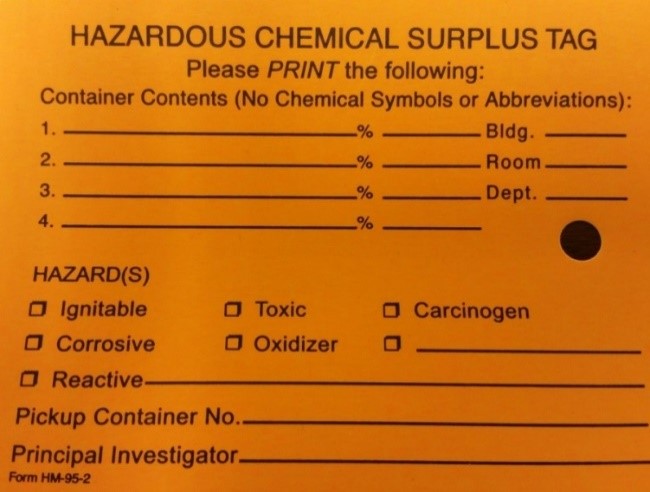Labeling and Signage Guide
Labels and signage are the cornerstones of hazard communications. They provide the ability to locate and identify laboratory hazards. The guidance on this page is intended to provide unambiguous instructions regarding chemical labeling, hazardous waste labeling, entrance signage, chemical storage, location of safety equipment, and unattended experiments. Specific dimensions and ordering information can be found on the Purchasing Guide Sheet.
Signage
Proper signage at a laboratory entrance provides important information about the hazards located inside, as well as required personal protective equipment (PPE). This information is extremely valuable for responders and visitors and reminds employees of the hazards they encounter upon entering a laboratory. Signage inside the laboratory designates the locations for safety equipment, chemical storage, and unattended experiments. Standardized guidance, listed below, provides easy identification of hazards and locations of safety equipment in case of an emergency.
Standardized Guidance
- All signs will be conspicuously posted in each area where hazardous chemicals are used or stored. These signs must be written in English.
- Current laboratory emergency points of contact (POC) information must be posted, which should include a name and a 24-hour contact number.
- Signage at laboratory entrances should represent the current laboratory hazards. It should include Global Harmonized System (GHS) hazard pictograms (≥2 in), emergency contact information, required PPE (≥2 in), and the National Fire Protection Association (NFPA) 704 diamond (≥4 in).
- Signage should be placed on the wall near the door and not on the laboratory door.
GHS (a), PPE (b), and NFPA Diamond (c) Signage
- Laboratory safety equipment must be easy to locate. Locations of the portable fire extinguisher, eyewash station, and safety shower should have signs that are ≥6 inches in both height and width.
Eyewash and Safety Shower Signage
- Laboratories or work areas with non-chemical hazards such as a magnetic field, radioactivity, biological hazards, heat, crygenic, molten metals, high electrical energy etc. should have the appropriate warning signs posted at each entrance.
- Chemical and hazardous waste storage locations inside the laboratory must be clearly marked with lettering at least 1 inch in height.
- Chemical storage areas should be labeled using signage at least 1 inch in height. Visitors or responders should be able to easily find chemical storage locations.
Examples for Marking Chemical Storage Areas
- For unattended experiments, post a notice on or near the experiment. The notice should clearly communicate the emergency shutoff procedures, nature of the hazards, and contact information.
Chemical Labeling
Labeling of chemical containers is fundamental to effective hazard communication. The manufacturer provides compliant labeling for each chemical they sell. However, OSU labeling standards are needed for labeling secondary containers and expiration sensitive chemicals such as peroxide formers.
OSU Labeling Standards
- Manufacturers' chemical labeling should remain intact and undamaged
- All chemicals must be prominently and accurately labeled. The full chemical name must be in legible English. Formulas and abbreviations are not acceptable.
- Unlabeled chemicals must not be stored or used.
- Make sure all labels are legible and intact. Periodically check inventory for labels that may have degraded or fallen off. Labels must be on containers that are designated for chemical pick up.
- Date all peroxidizable and other chemicals that may become unstable over time. They should display the arrival date, date opened, and latest date tested. Expiration dates may be extended based on testing.
- All secondary containers must be labeled with common name, chemical name, and the NFPA diamond. Dilutions should be labeled with common name, chemical name, concentration, and the NFPA diamond if it's hazardous.
Example Labels for Secondary (a) and Dilute (b) Chemicals
Hazardous Waste Labeling
- Waste containers must have accurate labeling. A Hazardous Waste label must be attached to any unlabeled container or any container with contents that do not match the original manufacturer's label. The label must clearly and neatly list the chemical or common name of each substance that is at least 1% by volume of the total contents or mixture.
Hazardous Chemical Surplus Tag for Hazardous Waste
- Carcinogens or highly toxic substances (0.1% or more by volume) must also be listed. Any amount of a heavy metal (e.g. As, Ba, Cd, Cr, Hg, Ni, Se, Ag, Th) greater than 1 part per million (1 ppm) in the container must be listed.
- Indicate the strength or concentration of the substance where applicable. For example, hydrochloric acid may have strength of 10%, 28%, or 38%.
- Do not use chemical formulas, chemical symbols, chemical equations, or abbreviations. All labels must be written in English.
- Indicate the physical and/or health hazards of the substance, if known.
- Indicate the name of the building, room, and principal investigator (PI) or person responsible for generating the waste, or someone with direct knowledge of the process.
- In the instances of time-sensitive substances such as ethers, the date of container opening or initial accumulation should be included on the form.
- Remove or obliterate any other labels or wordings that are not related to the current substance.
- Do not allow the creation of "UNKNOWNS" through the lack of secure labeling.





